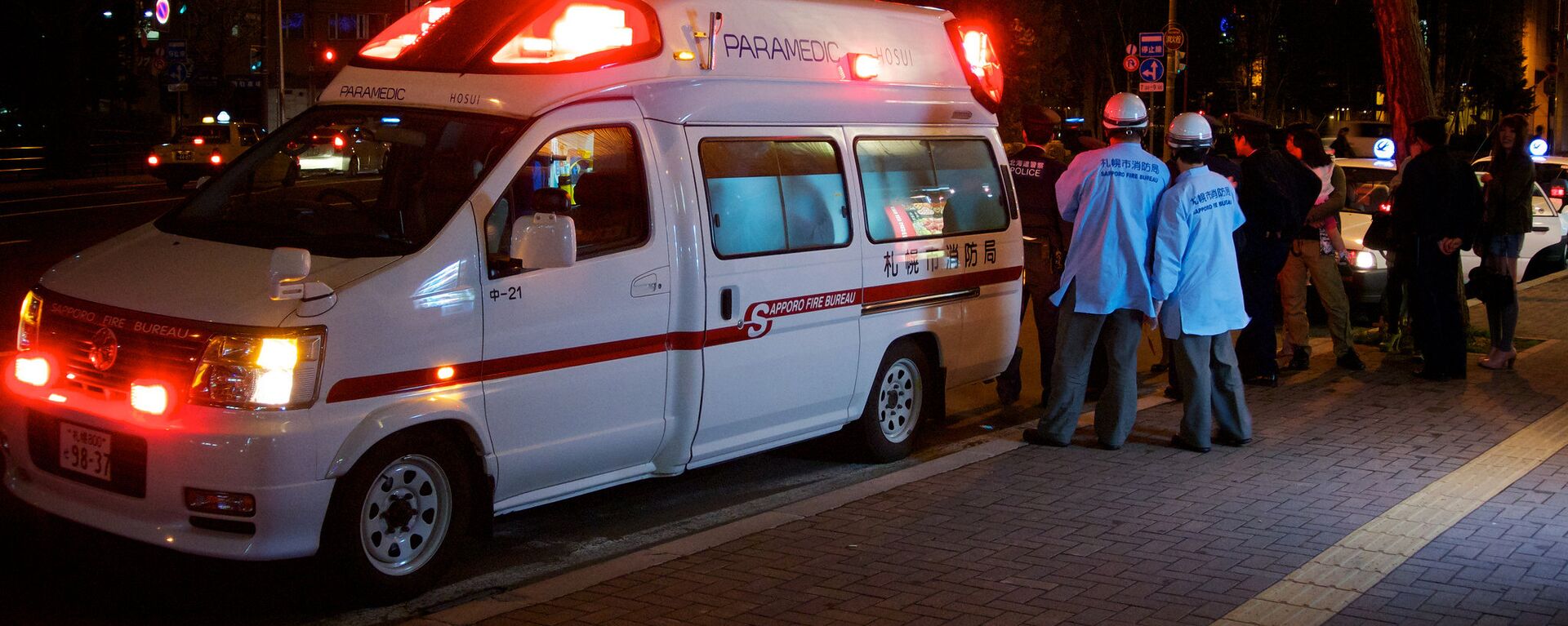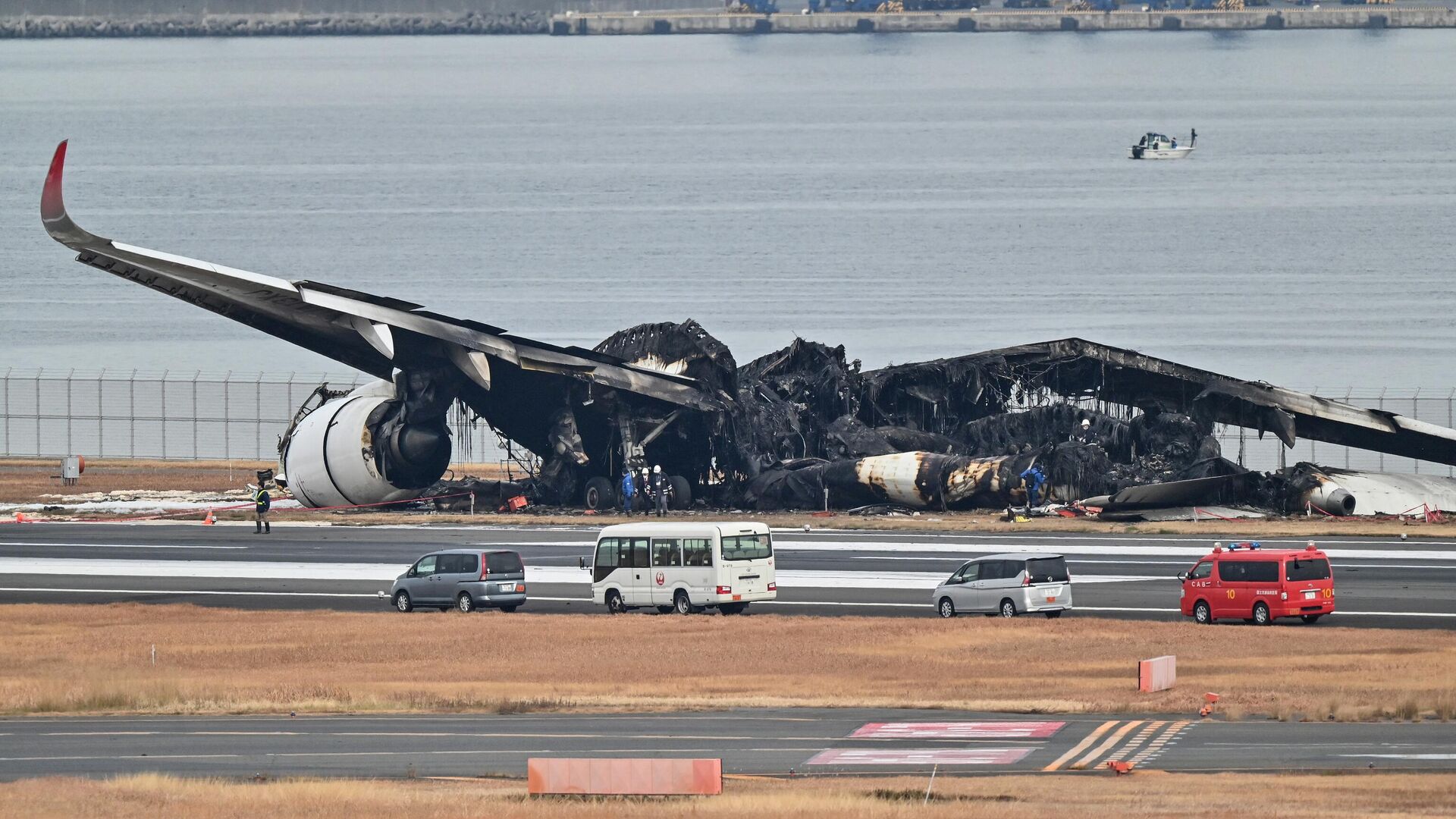https://sputnikglobe.com/20240104/transcripts-reveal-japanese-coast-guard-not-given-takeoff-clearance-before-deadly-crash-1115968302.html
Transcripts Reveal Japanese Coast Guard Not Given Takeoff Clearance Before Deadly Crash
Transcripts Reveal Japanese Coast Guard Not Given Takeoff Clearance Before Deadly Crash
Sputnik International
The Coast Guard turboprop plane that collided with a landing Airbus A350 was not given permission to enter the runway, according to transcripts provided by Japanese authorities.
2024-01-04T00:43+0000
2024-01-04T00:43+0000
2024-01-04T00:39+0000
asia
japan
tokyo
airbus
coast guard
japan airlines
a350
plane crash
https://cdn1.img.sputnikglobe.com/img/07e8/01/04/1115968146_0:160:3072:1888_1920x0_80_0_0_85fc13c3867f20f31fd435e4c06df899.jpg
Japanese authorities revealed on Wednesday that the Japan Airlines Airbus A350 that was hit by a Coast Guard turboprop plane on the runway had been given permission to land, but that there were no indications the Coast Guard plane was permitted to take off.On Tuesday, the De Havilland Dash-8 Coast Guard turboprop plane was scheduled to deliver aid to regions of the country that were hit by a devastating earthquake on Monday. Instead, it collided with the landing Airbus A350 at Tokyo’s Haneda airport.All 367 passengers and 12 crew members of the Airbus were able to escape the plane unharmed in a 20-minute evacuation which has been described as a miracle by Japanese authorities. The same cannot be said of the smaller plane: five of its six crew members were killed and the survivor, the captain, suffered major injuries. Some 14 passengers on the Airbus were injured, but they have been described as non-life-threatening.The Airbus burned for more than six hours on the runway after the accident, causing authorities to cancel 137 domestic and four international flights. Emergency flights and high-speed rail services were provided to reduce congestion.According to transcripts released by authorities, the Airbus was permitted to land, while the Turboprop plane was told to taxi to a holding point.The transcripts appear to contradict the captain, who said following the crash that he had been given permission to enter the runway.A US inspector bulletin stated that a string of lights, which would have told the pilot where to stop before the runway was inoperable. However, experts have pointed out there are other indicators, like reflective paint, that serve the same purpose.Experts have also told media outlets that airline crashes that are the result of one failure are rare and it is more likely there were several contributing factors. The investigation is still in its early stages and the Coast Guard plane’s voice recorder was recovered, which may provide more insight.The Japan Safety Transport Board (JTSB) is investigating the accident. Agencies from France, the UK and Canada, where parts of the two planes were produced, will assist in the investigation.Additionally, the Tokyo police are investigating if criminal negligence led to the crash, according to Japanese media outlets. An investigation unit has been established at the airport.
https://sputnikglobe.com/20240102/five-people-on-board-japan-coast-guard-aircraft-died-following-collision---reports-1115946769.html
japan
tokyo
Sputnik International
feedback@sputniknews.com
+74956456601
MIA „Rossiya Segodnya“
2024
News
en_EN
Sputnik International
feedback@sputniknews.com
+74956456601
MIA „Rossiya Segodnya“
Sputnik International
feedback@sputniknews.com
+74956456601
MIA „Rossiya Segodnya“
japan plane crash, runway plane crash, coast guard crash in japan
japan plane crash, runway plane crash, coast guard crash in japan
Transcripts Reveal Japanese Coast Guard Not Given Takeoff Clearance Before Deadly Crash
Haneda airport, often called Tokyo International Airport, is known for its high safety record, having been awarded a five-star designation by SKYTRAX Global Airport Rating.
Japanese authorities revealed on Wednesday that the Japan Airlines Airbus A350 that was hit by a Coast Guard turboprop plane on the runway had been given permission to land, but that there were no indications the Coast Guard plane was permitted to take off.
On Tuesday, the De Havilland Dash-8 Coast Guard turboprop plane was scheduled to deliver aid to regions of the country that were hit by a devastating earthquake on Monday. Instead, it collided with the landing Airbus A350 at Tokyo’s Haneda airport.
All 367 passengers and 12 crew members of the Airbus were able to escape the plane unharmed in a 20-minute evacuation which has been described as a miracle by Japanese authorities.
The same cannot be said of the smaller plane: five of its six crew members were killed and the survivor, the captain, suffered major injuries. Some 14 passengers on the Airbus were injured, but they have been described as non-life-threatening.
The Airbus burned for more than six hours on the runway after the accident, causing authorities to cancel 137 domestic and four international flights. Emergency flights and high-speed rail services were provided to reduce congestion.
According to transcripts released by authorities, the Airbus was permitted to land, while the Turboprop plane was told to taxi to a holding point.
JAL516 [Airbus]: Tokyo TOWER JAL516 spot18 [17:43:02]
Tokyo Tower: JAL516 RUNWAY 34R cleared to land, wind 310/8 [17:44:56]
JAL516: Cleared to land RUNWAY 34R JAL516 [17:45:11]
JA722A [Coast Guard plane]: TOWER JA722A C. [17:45:11]
Tokyo Tower: JA722A Tokyo TOWER good evening, No.1, taxi to holding point C5 [17:45:11]
JA722A: Taxi to holding point holding point C5 JA722A No.1, Thank you. [17:45:19]
The transcripts appear to contradict the captain, who said following the crash that he had been given permission to enter the runway.

2 January 2024, 13:23 GMT
A US inspector bulletin stated that a string of lights, which would have told the pilot where to stop before the runway was inoperable. However, experts have pointed out there are other indicators, like reflective paint, that serve the same purpose.
Experts have also told media outlets that airline crashes that are the result of one failure are rare and it is more likely there were several contributing factors. The investigation is still in its early stages and the Coast Guard plane’s voice recorder was recovered, which may provide more insight.
The Japan Safety Transport Board (JTSB) is investigating the accident. Agencies from France, the UK and Canada, where parts of the two planes were produced, will assist in the investigation.
“The transport ministry is submitting objective material and will fully cooperate with the ... investigation to ensure we work together to take all possible safety measures to prevent a recurrence,” Transport Minister Tetsuo Saito said during a news conference.
Additionally, the Tokyo police are investigating if criminal negligence led to the crash, according to Japanese media outlets. An investigation unit has been established at the airport.



